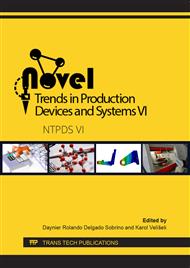[1]
J. Bílik, J. Bača, Mechanické spevňovanie povrchových vrstiev dynamickým guľôčkovaním, in: 13. mezinárodní konference metalurgie a materiálů METAL 2004, Hradec nad Moravicí, (2004).
Google Scholar
[2]
http://gps.fme.vutbr.cz/STAH_INFO/2512_Bumbalek.pdf.
Google Scholar
[3]
V. Sedláček, Metallic Surfaces, Films and Coatings. ELSEVIER. Amsterdam – London – New York – Tokyo, (1992).
Google Scholar
[4]
V. Sedláček, Zotavenie a rekryštalizácia, Academia Praha, (1985).
Google Scholar
[5]
P. Blaškovits, J. Balla, M. Dzimko, Tribológia, Alfa, Bratislava, (1990).
Google Scholar
[6]
L. G. Odincov, Upročnenie i otdelka detalej, MAŠINOSTROENIE, Moskva, (1987).
Google Scholar
[7]
F. Neckář, Vliv řezného procesu na integritu povrchu, in: 4. celoštátna konferencia Obrábanie ťažkoobrobiteľných materiálov, DT ČSVTS, Bratislava (1985).
Google Scholar
[8]
A. Puškár, Mikroplastickosť a porušenie kovových materiálov, VEDA, Bratislava, (1986).
Google Scholar
[9]
M. Králik, M. Horvát, M. Bachratý, Surface layer hardening, in: Scientific Proceedings Faculty of Mechanical Engineering STU Bratislava, - ISSN 1338-1954. - Vol. 21/2013. – Bratislava, Nakladateľstvo STU, 2013, pp.107-112.
DOI: 10.2478/stu-2013-0009
Google Scholar
[10]
M. Králik, V. Jerz, The measurement of residual stresses in the surface layers of the materials after machining, in: Materials Science Forum ISSN 0255-5476, Vol. 919, pp.345-353. © 2018 Trans Tech Publications, Switzerland.
DOI: 10.4028/www.scientific.net/msf.919.345
Google Scholar
[11]
M. Králik, V. Jerz, Solving Selected Problems with Ultrasonic Surface Strengthening of Metal Components, in: Materials Science Forum ISSN 0255-5476, Vol. 952, Novel Trends in Production Devices and Systems V (NTPDS V), Special topic volume with invited peer reviewed papers only (2019), pp.22-28. © 2019 Trans Tech Publications, Switzerland,.
DOI: 10.4028/www.scientific.net/msf.952.22
Google Scholar
[12]
M. Sedlaček, B. Podgornik, J. Vižintin, Influence of surface preparation on roughness parameters, friction and wear, Wear Volume 266, Issues 3–4, 5 February 2009, Pages 482-487.
DOI: 10.1016/j.wear.2008.04.017
Google Scholar
[13]
M. Buck, T. Straub, C. Eberl, Experimental investigation of damage detection and crack initiation up to the very high cycle fatigue regime, Fatigue of materials at very high numbers of loading cycles; Christ, H.-J. (Ed.); Springer Spektrum, Wiesbaden (2018) 365-393.
DOI: 10.1007/978-3-658-24531-3_17
Google Scholar
[14]
P.D. Babichev, I.A. Motrenko, et al., Otdelochnouprochnyayushchaya obrabotka detalei mnogokontaktnim vibroudarnim instrumentom (Finishing Strengthening Processing of the Components by Multi Contact Vibroimpact Instrument), Rostov-on-Don: Izd.center DGTU, (2003).
Google Scholar
[15]
M. A. Tamarkin, E. E. Tischenko, V. G. Lebedenko, Component surface layer improvement during finishing-strengthening processing in granular working medium, Russian Engineering Research, April 2007, Volume 27, Issue 4, p.238–240.
DOI: 10.3103/s1068798x07040168
Google Scholar
[16]
J. Bílik, M. Hudáková, Spevňovanie povrchových vrstiev zápustiek, tvárniacich nástrojov a súčiastok, Kovárenství Vol. 68/2019, pp.101-104.
Google Scholar


